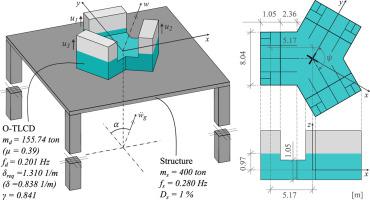当前位置:
X-MOL 学术
›
J. Sound Vib.
›
论文详情
Our official English website, www.x-mol.net, welcomes your
feedback! (Note: you will need to create a separate account there.)
Mathematical modeling and optimization scheme for omnidirectional tuned liquid column dampers
Journal of Sound and Vibration ( IF 4.3 ) Pub Date : 2020-10-01 , DOI: 10.1016/j.jsv.2020.115523 Behnam Mehrkian , Okyay Altay
Journal of Sound and Vibration ( IF 4.3 ) Pub Date : 2020-10-01 , DOI: 10.1016/j.jsv.2020.115523 Behnam Mehrkian , Okyay Altay

|
Abstract As a well-known and reliable control device, tuned liquid column dampers (TLCDs) have been investigated numerically and experimentally and implemented in a number of structures over the last three decades. However, TLCDs basically suffer from the lack of multidirectionality, which is the critical need for real structures, in particular under random vibrations such as wind and earthquake excitations. This aspect has garnered the attention of the structural control community to modify this promising damper to achieve more efficiency and to extend its application range to multidirectional vibrations. This paper proposes a mathematical modeling and optimization approach for omnidirectional tuned liquid column dampers (O-TLCDs). As an improved and reformed TLCD, O-TLCDs are formed by circularly distributed of n (integer n ≥ 3) L-arms about a common joint point at the center, through which all L-arms are connected to each other. Thanks to this layout, O-TLCDs can control structures with full counteracting force capacity in all transversal directions regardless of the excitation angle of incidence. This paper, in the first step, proposes the governing equation of motion of O-TLCDs, for which Lagrange's principle is employed, and the equation of motion of the coupled O-TLCD-structure system. In doing so, a formal solution to determine the degree of freedom (DoF) of the O-TLCD is introduced, which proves independence of the O-TLCD response from the number of L-arms as well as from the angle of excitations. Second, for designing O-TLCDs, a set of design criteria and a general optimization scheme, which accommodate the online simulation of coupled O-TLCD-structure system under arbitrary excitations, are proposed. Consequently, without adding extra complication coming from extra DoFs to the motion equation of the damper, the O-TLCD functions as an enhanced liquid damper for multidirectional vibration attenuation. Next, using the O-TLCDs designed with different mass ratios, numerical simulations of O-TLCD-structure systems are conducted under seismic loads, free vibration, harmonic excitation and white noise and the controlled and uncontrolled responses of the systems are assessed in the time and the frequency domain. Here, the role of important parameters such as the mass ratio, the head loss coefficient, the liquid deflection and the excitation amplitude are evaluated and the influence of varying conditions on the efficiency of the O-TLCD are discussed. Results demonstrate that the proposed O-TLCD can be well tuned to the structure and markedly control the peak and the RMS of responses of the structure. In the end, an experimental study on a prototype O-TLCD is performed using a shaking table, which verifies the proposed mathematical modeling approach.
中文翻译:

全向调谐液柱阻尼器的数学建模与优化方案
摘要 作为一种众所周知且可靠的控制装置,调谐液柱阻尼器 (TLCD) 在过去的 30 年中已经进行了数值和实验研究,并已在许多结构中实现。然而,TLCD 基本上缺乏多向性,这是真实结构的关键需求,特别是在风和地震激发等随机振动下。这方面已经引起了结构控制界的注意,以修改这种有前途的阻尼器以实现更高的效率并将其应用范围扩展到多向振动。本文提出了一种全向调谐液柱阻尼器 (O-TLCD) 的数学建模和优化方法。作为经过改进和改造的 TLCD,O-TLCD 由 n(整数 n ≥ 3)个 L 臂围绕中心的公共关节点呈圆形分布形成,所有 L 臂通过该关节点相互连接。由于这种布局,无论激发入射角如何,O-TLCD 都可以在所有横向方向上控制具有完全反作用力能力的结构。本文首先提出了采用拉格朗日原理的O-TLCD 运动控制方程和耦合O-TLCD 结构系统的运动方程。在此过程中,引入了确定 O-TLCD 自由度 (DoF) 的正式解决方案,这证明了 O-TLCD 响应与 L 臂数量和激励角度无关。其次,对于设计O-TLCD,一套设计标准和一个通用的优化方案,提出了可以在任意激励下对耦合的 O-TLCD 结构系统进行在线仿真。因此,O-TLCD 无需将额外自由度带来的额外复杂性添加到阻尼器的运动方程中,即可用作增强型液体阻尼器,用于多向振动衰减。接下来,利用不同质量比设计的O-TLCDs,对O-TLCD结构系统在地震荷载、自由振动、谐波激励和白噪声下进行数值模拟,并及时评估系统的受控和非受控响应。和频域。这里,重要参数如质量比、水头损失系数、评估了液体偏转和激励幅度,并讨论了变化条件对 O-TLCD 效率的影响。结果表明,所提出的 O-TLCD 可以很好地适应结构,并显着控制结构的响应峰值和 RMS。最后,使用振动台对原型 O-TLCD 进行了实验研究,验证了所提出的数学建模方法。
更新日期:2020-10-01
中文翻译:

全向调谐液柱阻尼器的数学建模与优化方案
摘要 作为一种众所周知且可靠的控制装置,调谐液柱阻尼器 (TLCD) 在过去的 30 年中已经进行了数值和实验研究,并已在许多结构中实现。然而,TLCD 基本上缺乏多向性,这是真实结构的关键需求,特别是在风和地震激发等随机振动下。这方面已经引起了结构控制界的注意,以修改这种有前途的阻尼器以实现更高的效率并将其应用范围扩展到多向振动。本文提出了一种全向调谐液柱阻尼器 (O-TLCD) 的数学建模和优化方法。作为经过改进和改造的 TLCD,O-TLCD 由 n(整数 n ≥ 3)个 L 臂围绕中心的公共关节点呈圆形分布形成,所有 L 臂通过该关节点相互连接。由于这种布局,无论激发入射角如何,O-TLCD 都可以在所有横向方向上控制具有完全反作用力能力的结构。本文首先提出了采用拉格朗日原理的O-TLCD 运动控制方程和耦合O-TLCD 结构系统的运动方程。在此过程中,引入了确定 O-TLCD 自由度 (DoF) 的正式解决方案,这证明了 O-TLCD 响应与 L 臂数量和激励角度无关。其次,对于设计O-TLCD,一套设计标准和一个通用的优化方案,提出了可以在任意激励下对耦合的 O-TLCD 结构系统进行在线仿真。因此,O-TLCD 无需将额外自由度带来的额外复杂性添加到阻尼器的运动方程中,即可用作增强型液体阻尼器,用于多向振动衰减。接下来,利用不同质量比设计的O-TLCDs,对O-TLCD结构系统在地震荷载、自由振动、谐波激励和白噪声下进行数值模拟,并及时评估系统的受控和非受控响应。和频域。这里,重要参数如质量比、水头损失系数、评估了液体偏转和激励幅度,并讨论了变化条件对 O-TLCD 效率的影响。结果表明,所提出的 O-TLCD 可以很好地适应结构,并显着控制结构的响应峰值和 RMS。最后,使用振动台对原型 O-TLCD 进行了实验研究,验证了所提出的数学建模方法。











































 京公网安备 11010802027423号
京公网安备 11010802027423号